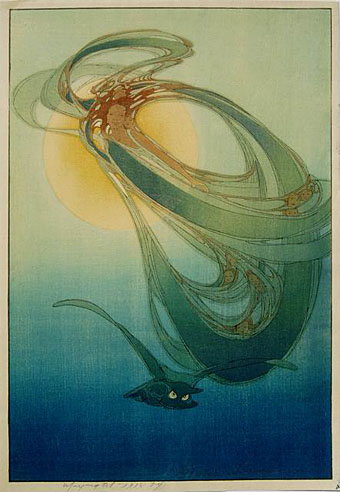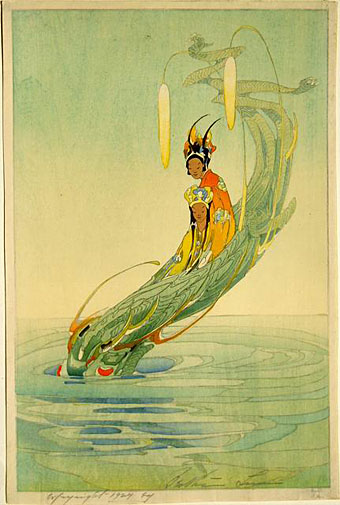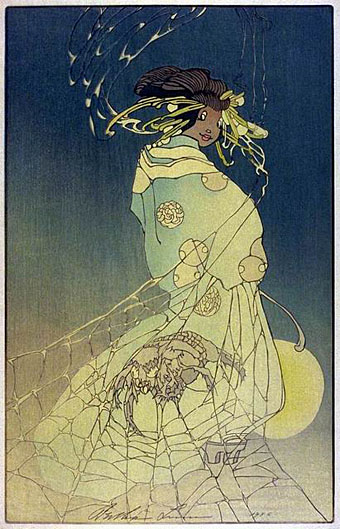Mother West Wind (1918).
The first thought which comes to mind when looking at these beautiful prints is to wonder why American artist Bertha Lum isn’t more well-known, she had a particularly fondness for fluid lines and swirling arabesques as in the example above. There is at least a wealth of detail about her career online, and her biography shows her to be far more than a careful pasticheur like Edmund Dulac and others. She travelled to Japan specially to learn printmaking, and her later works were produced in collaboration with Japanese artisans. No surprise to see she was attracted to the works of Lafcadio Hearn (1850–1904), another Westerner who did much to introduce the rest of the world to Japanese folklore—especially the ghost stories—during the late Victorian era.
The Dragon King and his Bride (1924).
• Four pages of catalogued works at Bertha-lum.org
• Biography page in English and a reference gallery
Spider Woman (1936).
Elsewhere on { feuilleton }
• The illustrators archive
Previously on { feuilleton }
• The Boy Who Drew Cats
• More Arabian Nights




Get ready for another long winded post. The third picture here interests me especially because it is yet another example of an intriguing trend in the arts in general that I’ve noticed over the years. In all manner of media, be it literature, motion picture, games and what-have-you, in examples both ancient and contemporary, there is an ongoing tradition across many cultures of female spiritual or mythological beings who either have many arachnid features about their figure and/or nature, or have a close association with spiders and their brethren.
There are innumerable examples of this from historic traditions be they the primal godess of many American Indian tribes- whose shape is that of a spider and who originally held the universe in place with her web, similar examples from Far Eastern legends, or hell that massive she-spider from one of those ‘Lord of the Rings’ books. Mythos from the ancient Mediterranean and Middle East have many mysterious female entities associated with subterranean places and the scittering invertabrates found therein, Ereshkigal being an example of this, in addition to an ititiatory woman/thing from Mesopotamian legends whose name I cannot recall.
This is even more popular in contemporary art. Countless games and comics, Elder Scrolls, Castlevania, and a plethora Japanese examples that I cannot pronounce, are riddled with examples of centaur-like beings, whose main differences with their ancient Greek counterparts are, their upper bodies are those of women or obviously feminine in some way and their lower bodies are those of spiders. Many contemporary illustrators such as Chad Savage and Tom Fuckin’ Crites have recurring themes of femme fatales whose anatomy is at least partially, if not more so arachnid. On a related note, many modern artists, especially those dealing in comics or fringe publications, who depict various many-armed godesses from say Hindu traditions, Kali being the most obvious example, often graphically associate them with the myriad jointed limbs of spiders, scorpions, centipedes, and so forth, while all but ignoring male counterparts such as Shiva.
Sure there a plentiful examples of she-beasts who are not remotely arachnid in nature, but there are just as many and probably many more masculine examples of these from both contemporary and antique world mythologies. The spider however almost seems reserved for the ladies. Very few prominent masculine examples spring to mind; Spider-Man obviously, but he’s a superhero and not a very cool one mind you, there is the war-god of the Andean mountains known to the Peruvian natives as ‘the Decapitator’ but he had just as many feline, reptilian, and humanoid aspects as he did arachnid. The only other example I can think of is that man Robert Smith seemed so afraid in that one Cure song from the Disintigration album, that’s it. I can’t be the only one who has ever pondered over this.
From a scientific perspective, it makes perfect sense, after all in most arthropods, but especially so regarding spiders, the females tend to be larger (in some cases absolutely dwarfing males), and more aggressive/venomous, often killing or even devouring those helpless, disgraceful little males after a cat&mouse game of sex, I am sure Lydia Lunch or any similar woman of letters would have approved. However the ancients and even those from a few hundred years ago would not have known about this. It is fairly common knowledge today, but I wouldn’t go so far as to call it household knowledge. Cartoonists like Gary Larson, the man behind the ‘Far Side’, leave many people I know (know, not like) scratching their empty heads, bewildered.
So where on earth did this trend originate from or is it really part a tradition more ancient than Tantra or Shamanism? I’ve actually thought about this before. Once I asked a fairly nerdy friend of mine who I wasn’t ashamed of talking like this to, for his opinions regarding this. He found the idea, though he agreed there were many examples of it, to be very strange nevertheless, the main reason being that he found it unexpected to associate something of a female nature with something ‘he’ found so ugly.
After having this conversation, I gave it a little thought and then realized then that I found him and also most ‘modernized’ cultures even stranger than I had before. I am straight in orientation, wherever that way of wording it came from, I guess its sensible enough that no one wants to say a long word like heterosexual all the time, but I have never understood the idea behind referring to Woman-kind as the ‘fairer sex’. I think that if one is honest with oneself, not always a fun thing to do, however, one will find that there are rather distasteful as well as appealing about either gender. Shit I know a lot of rather homophobic guys who loved the movie ‘300’ and you can bet your ass they would not have liked it so much if those Spartans, most of whom didn’t even resemble Greeks, weren’t wearing next to nothing on their sweaty, feral bodies. So why not make some female beings of shape and aspect that most would find unpleasant or even disgusting? Hell they did it with the Gorgons, though I’ve certainly no problem with snakes at all.
From my point view now, black and white views of the world were relatively foreign to the ancients, at least, in comparison to how it is today. There were just as many statues of naked men as there were of women because they were mature enough not to be bothered by it, and likewise just because something may have been potentially dangerous, like a venomous spider, they did not automatically associate fearsomeness with ugliness as many today are prone to do. So perhaps, though she is to respected and feared, the spider-woman is ‘not’ something intended to churn the spectators’ bowels.
Spiders are, after all, far more symmetrical in form than anyone you or I are likely to ever meet, and even those who are incredibly phobic of them cannot deny how graceful and swift they are, nor the beauty of their webs, otherwise dreamcatcher ornaments would not be so popular, being modeled upon the spiderweb. Anyway, its a trend or tradition, whichever, that I’ve always liked, if you had any other examples of it, I’d love to see them, maybe I’ll put some links under another comment, I think I’ve said enough for now though.
The spider in LOTR, Shelob, is female also.
For any explanation of myth you usually have to go as far back as possible. So in this case the thing to do is to look at spiders and see them in the way Stone Age peoples would have done. In Stone Age terms, spiders aren’t hunters the way other predators are (including men), they mostly weave webs then sit and wait. In Stone Age culture sitting at home and weaving was a woman’s job so I’d see that as the basis of any subsequent myths. Malevolent females in myth are often connected with luring (sirens and mermaids) and entrapment, rather than active hunting; spiders are the ultimate metaphor for the latter.
And yeah; a spider woman post. I can think of a few examples already. That’s one for the future…
The irresistible oriental atracción